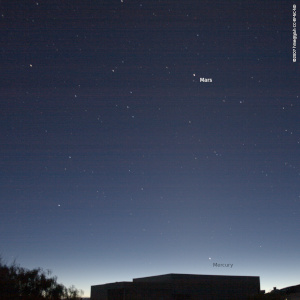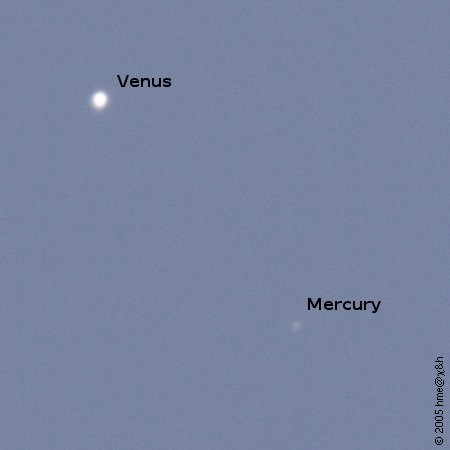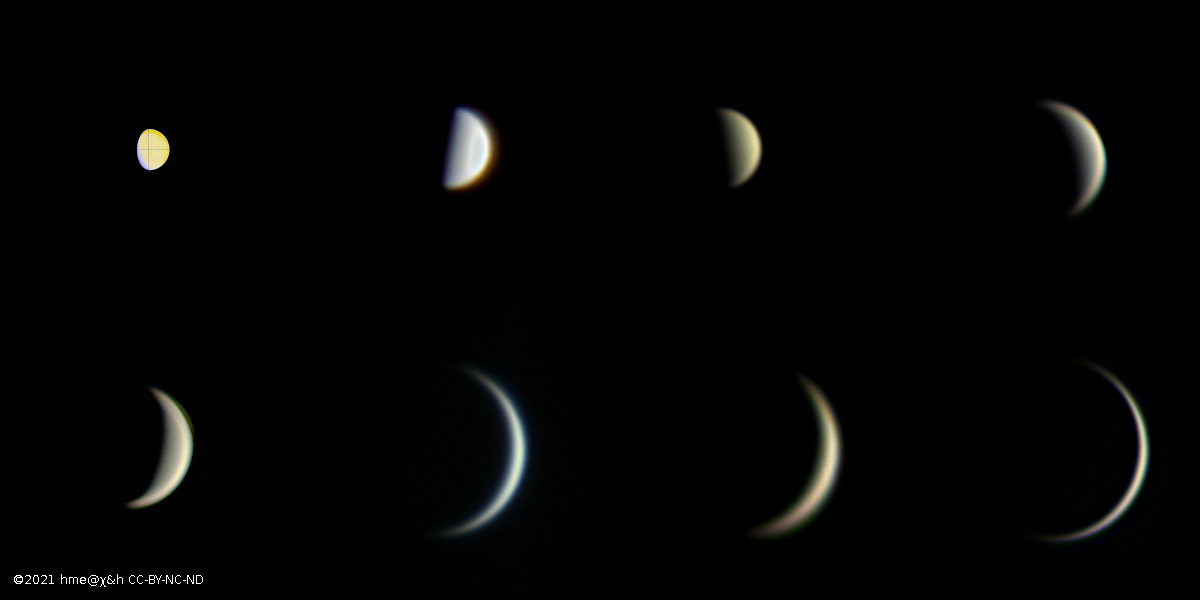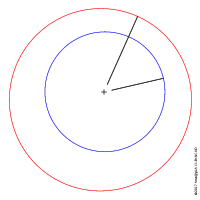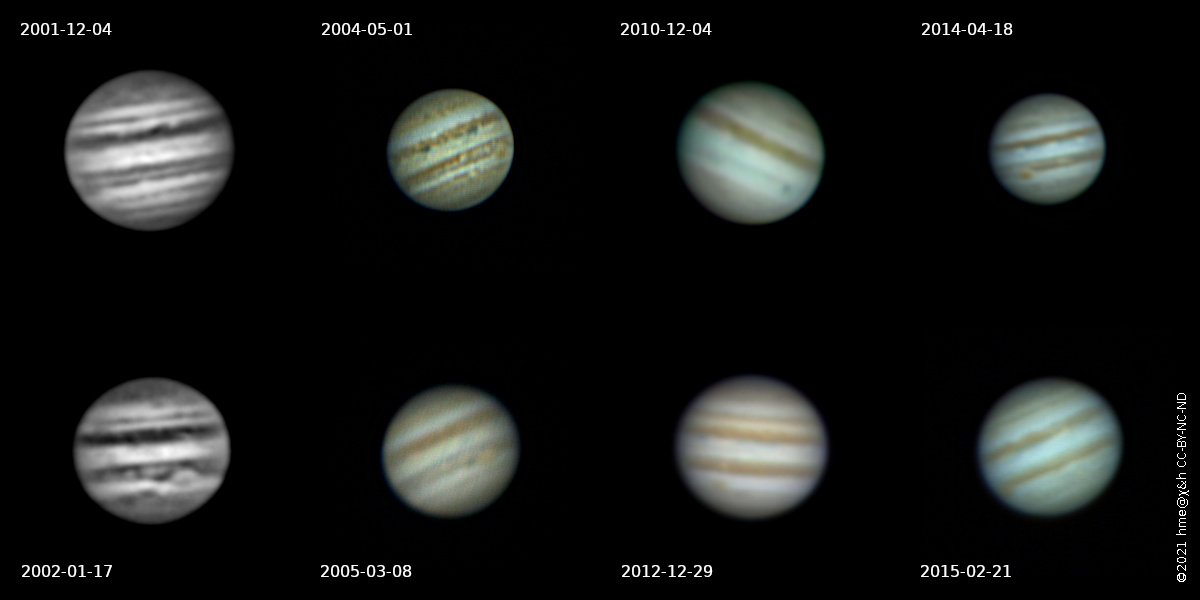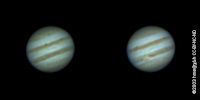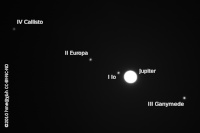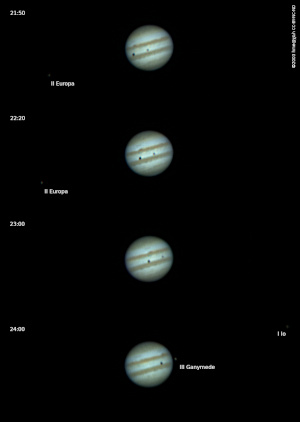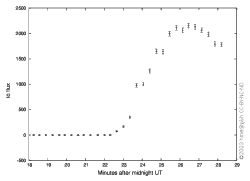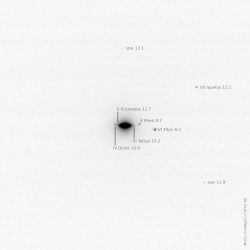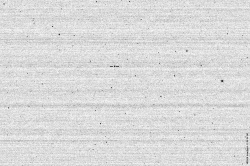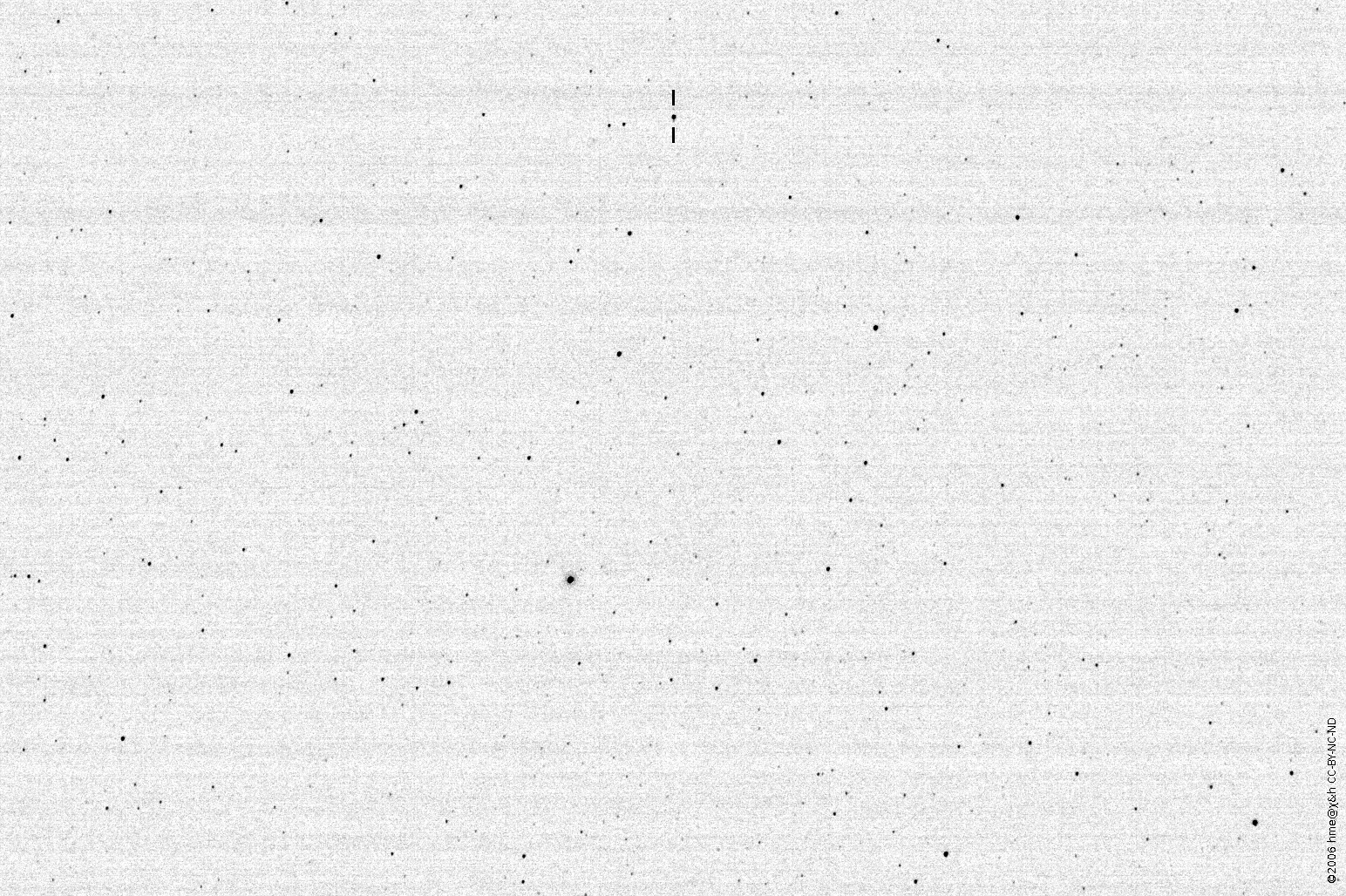
{ Practical astronomy | Astronomy | Planets | Telescopic appearance }
Telescopic appearance
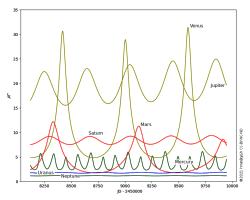
The apparent radii of the planets over the five years 2018–2022.
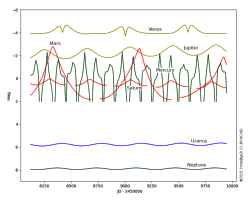
The apparent brightness of the planets over the five years 2018–2022.
The Solar System is basically empty; planets are small compared to the space between them. The classical planets typically have an apparent radius of less than about 20". This means that we need high magnification and long focal length to see them as more than star-like points of light. On the other hand, the classical planets (Mercury to Saturn) are as bright as the brightest stars. Uranus is technically just visible to the naked eye, but Neptune definitely requires binoculars at least.
The bright planets are best imaged by taking videos of a few hundred frames and stacking these; a few thousand frames may be feasible with a fast frame rate. A cheap webcam can serve well; a recent dSLR may prove useful; a dedicated CCD- or CMOS-camera with video capability might be the best choice.
Guiding is not necessary and over the short exposures entirely ineffective. A tracking mount is preferable, but good results can also be had in the brief interval in which the planet drifts through the field of view of a stationary telescope like a Dobsonian. The length of video is limited not only by the drift of the planet across the camera. It is also limited to a very few minutes, because the planet's rotation will begin to smear out the image, at least for Mars and Jupiter, where good detail can otherwise be imaged.
Focal length is key to allow the camera pixels to record the small detail; 2000 mm at least, better 4000 mm or 6000 mm. Aperture is an advantage to actually provide the angular resolution and show the small detail; 200 mm at least, better 250 mm, 300 mm or 400 mm.
Mercury
The apparent radius of Mercury ranges from 2.5" at superior conjunction to 5.5" at inferior conjunction. It is brightest at superior conjunction with about −2 mag and fades a lot near inferior conjunction. Around maximum elongation the brightness tends to be a moderate 0 or −0.5 mag.
A significant constraint to observing Mercury is that its angular distance from the Sun is at best 28°. The periods of significant elongation are also rather short. For an observer at 50° latitude the planet may hardly exceed 10° altitude at civil twilight for more than a few days. This is so even in a favourable elongation, i.e. a morning apparition in autumn or an evening apparition in spring. Optimal conditions can be had on the tropic of Cancer or Capricorn, in a spring evening or autumn morning apparition.
Ironically, it is pure coincidence that all these things come out right without preparation, or knowledge, on my part. The horizon in the image is completely misleading; the trees are the only ones for 100 km and the "factory building" is the gym of the European Southern Observatory on Cerro Paranal. For once I am allowed to leave behind my computers in Scotland and work at an observatory in the Atacama desert. This is April, autumn in the southern hemisphere. It is three weeks after greatest western elongation with an exceptional distance of 28° between Mercury and the Sun; the distance is still 20° at the time of the picture.
Out of nautical morning twilight appears Mercury from behind the building. Mars is vertically above Mercury, indicating that the ecliptic at this latitude and time of year stands vertical on the horizon. Mercury is 10° above the horizon and the Sun must then be 10° below the horizon.
Image parameters:
- Mount: stationary on tripod
- Lens: 18–55 mm zoom lens
- Focal length: 18 mm, f/3.5
- Camera: Canon EOS 300D
- Field of view: 40°
- Filters: none, outdoor/Sun white balance
- Exposure: 30 s at 100 ISO
- Processing: raw data with logarithmic stretch
- Location: Cerro Paranal, Chile
Observation in daylight may be possible, if an accurate setup of the telescope mount has been accomplished. A rare occasion was the close conjunction between Venus and Mercury on 2005-06-27, when the two planets were only 4' apart. Venus is easier to find in daylight and with Mercury in the same telescopic field of view at that time it can be observed, too.
Even at high magnification is it not possible to observe any detail other than the phase of illumination. The small apparent diameter and the need to observe in twilight low on the horizon are against us.
Venus
The apparent radius of Venus ranges from 5" at superior conjunction to about 30" at inferior conjunction. This is the largest apparent radius of all planets. Venus' brightness ranges from −4 mag to nearly −5 mag; it is brightest near greatest elongation. While all planets are unobservable around superior conjunction, at inferior conjunction Venus is bright enough and may be offset north or south from the Sun sufficiently to remain observable. This also has to do with its dense atmosphere, which extends the phase from its geometrical shape. A "new Venus" still shows a ring of light where the atmosphere refracts and scatters sunlight toward the Earth.
Although it is the planet with potentially the largest apparent diameter, and although it reaches much larger apparent distance from the Sun than Mercury, there is no detail to be seen in visible light, apart from the phase itself.
Image parameters:
- Mount: equatorial, tracking
- Telescope: Celestron 8, 200 mm Schmidt-Cassegrain; with 2× adapter
- Focal length: 3500 mm, f/17.5
- Camera: Philips ToUcam Pro
- Field of view: 1.5'
- Filters: none
- Exposure: webcam video, stacked
- Processing: unsharp mask
- Location: Edinburgh
The first is a drawing made in 1978 with the same telescope at 450× magnification. The images were obtained between 2004 and 2012 and are here sorted by phase and apparent size.
Mars
The apparent radius of Mars ranges from 2" at conjunction to between 7" and 13" at opposition. It is brightest at opposition with almost −3 mag and fades to +1.5 mag near conjunction.
Not all oppositions are equally good. The graph shows the orbits of Earth (blue) and Mars (red) around the Sun (black cross). This is to scale! We cannot see that the shape of the orbits deviates from the circle, but we can see that – at least for Mars – the Sun is not at the centre of the orbit. The black lines indicate the Earth's aphelion in early July and Mars' perihelion just under two months later in the Earth year. Hence, if a Mars opposition occurs in late August, Mars is only 56 Gm from Earth and its apparent radius is 13". If a Mars opposition occurs the other side of the orbits, in late February, it is 100 Gm away and has only 7" radius.
For observers at moderate northern latitudes this is not such good news, because the best Mars oppositions occur in summer, at southern declination, and the planet will not rise very high above the horizon. These observers might prefer a November opposition, when Mars can reach altitudes of 45° or more.
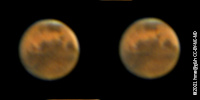
Rotation of Mars on 2005-11-18.
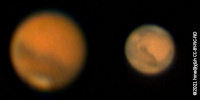
Mars on 2003-08-08 and 2007-12-15.
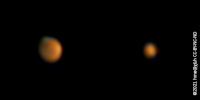
Phase and distance of Mars on 2012-05-26 and 2004-05-01.
These images of Mars are taken with the same telescope, and in most cases with the same camera setup. We can see bright lowlands and dark highlands, often also an indication of an ice cap in the North or South.
The top pair of images is taken 35 min apart to illustrate the rotation of Mars, which at 24h40m is very similar to that of the Earth. The left image was taken later; hopefully this can give a stereo effect to the pair of images.
The second pair of images intends to illustrate to observers in central and northern Europe that a December opposition may give better results than an August opposition. On the left, Mars is 12" in radius but only 15° above the horizon. On the right, the altitude of 50° improves the image much more than the decrease in apparent radius to 15" can spoil it.
While the inner planets Mercury and Venus show the full range of phases, the outer planets are never far from full. They are full both at opposition and at conjunction. Somewhere in between, Mars can show a phase of perhaps 90% illuminated fraction. The two images have Mars at 89% and 95% phase, and at distances of 172 Gm and 325 Gm, resp.
Image parameters:
- Mount: equatorial, tracking
- Telescope: Celestron 8, 200 mm Schmidt-Cassegrain; with 2× adapter
- Focal length: 3500 mm, f/17.5
- Camera: Philips ToUcam Pro
- Field of view: 1'
- Filters: none
- Exposure: webcam video, stacked
- Processing: unsharp mask
- Location: Edinburgh
Jupiter
For each planet, its distance from Earth varies approximately by the diameter of the Earth's orbit, farthest at superior conjunction and closest at opposition or inferior conjunction. For our neighbours Venus and Mars this is a huge relative change of distance and apparent size. For the planets beyond Mars, the change is relatively small and their apparent radius and brightness varies little over time.
The apparent radius of Jupiter ranges from 15" to 25". It is brightest at opposition with −2.5 mag or −3 mag and fades to about −2 mag near conjunction.
Jupiter shows by far the most surface detail, thanks to its size, to the temperature and chemistry at the top of its cloud layer, and to its fast rotation. In the pattern of bright and dark stripes the dark ones are called bands. Most prominent and almost always present are the two wide bands north and south of the equator, the NEB and SEB (North Equatorial Band and South Equatorial Band). The SEB more or less disappeared for much of 2010 and 2011.
With good image quality, much finer detail can be seen in the bands, such as thicker and thinner regions at different longitudes, bright spots or dark spots. At times the thin temperate bands NTB or STB, at higher latitudes than NEB or SEB, can be seen, or a thin band directly at the equator.
One large, dark spot is the Great Red Spot (GRS) that lies just south of the SEB. Its elliptical shape is about three times as wide in longitude than in latitude. The GRS is a long-lived high-pressure region in Jupiter's atmosphere, which was observed as long ago as 1665 or 1635.
Jupiter and Saturn rotate quite fast for their size. This leads to an obvious flattening at the poles.
Image parameters (for most of the images):
- Mount: equatorial, tracking
- Telescope: Celestron 8, 200 mm Schmidt-Cassegrain; with 2× adapter
- Focal length: 3500 mm, f/17.5
- Camera: Philips ToUcam Pro
- Field of view: 1.5'
- Filters: none
- Exposure: webcam video, stacked
- Processing: unsharp mask
- Location: Edinburgh
The Galilean moons
Jupiter has four bright moons that were already observed by Galileo in 1609 or 1610. But for the glare of Jupiter they would be naked-eye objects. Their distance from the planet is a few minutes of arc, which the naked eye can, in principle, resolve. There are rare reports of naked-eye observation of some of the outer Galilean moons. Moderate twilight may help in such observations, as it reduces the contrast between the planet and the sky background.
| mag |
R km |
ρ " |
P d |
a Gm |
a ' | ||
|---|---|---|---|---|---|---|---|
| I | Io | 4.8 | 1820 | 0.6 | 1.8 | 0.422 | 2.4 |
| II | Europa | 5.1 | 1560 | 0.5 | 3.6 | 0.671 | 3.8 |
| III | Ganymede | 4.4 | 2630 | 0.9 | 7.2 | 1.070 | 6.1 |
| IV | Callisto | 5.5 | 2410 | 0.8 | 16.7 | 1.882 | 10.8 |
Note the resonance between the inner three moons: Europa takes twice as long to orbit than Io and Ganymede takes twice as long again.
Imaging the Galilean moons meets similar difficulties as observing them with the naked eye. The brightness difference to Jupiter is immense, about a factor 2000. To image detail of the planet and record the moons at the same time requires a camera with 16-bit digitisation. Even then, trickery is required to cast such detail into the final 8-bit format for display on the screen. With a lesser camera one will have to overexpose Jupiter. Depending on the quality of the optics and detector, Jupiter is usually not this well-bounded ellipsoid, but can easily hide the close-by moons in its glare.
Image parameters:
- Mount: equatorial, tracking
- Telescope: Celestron 8, 200 mm Schmidt-Cassegrain
- Focal length: 2000 mm, f/10
- Camera: Canon EOS 300D
- Field of view: 10'
- Filters: none
- Exposure: 10 s, single frame
- Processing: linear stretch
- Location: Edinburgh
This image is OK. Compared to imaging Jupiter's surface detail, I removed the 2× adapter (fewer pieces of glass, thus less light scatter and reflection) and used a 12-bit dSLR with similar pixel size but larger detector size. The exposure of 10 s at this focal length requires reasonably good tracking.
Jupiter's equator has only a small obliquity to the ecliptic, and the Galiliean moons orbit near the equatorial plane of Jupiter. It is then quite common for the moons to
- pass in front of the planet (a transit),
- cast a shadow on the planet (a shadow transit),
- pass behind the planet (an occultation),
- pass through the shadow of the planet (an eclipse).
The sequence of images on the right shows a simultaneous transit and shadow transit of Ganymede. The apparently smaller dark spot on Jupiter is the moon, the larger and darker spot is its shadow. As time passes both move to the right and eventually the moon at least leaves the planet and moves into the black sky. In some images Io or Europa can be seen, depending on the precise field of view. The fourth moon, Callisto is too far to the left to be recorded.
An eclipse is not this appealing in images; now you see it, now you don't. For the graph shown left, a video clip with somewhat higher gain (or sensitivity) was taken and crude photometry extracted. The result is good enough to state that the moon emerged over a period of three or four minutes from Jupiter's shadow and that half the final brightness was reached at 00:24 UT.
Saturn
The apparent radius of Saturn ranges from 7" to 9"; The ring about doubles this to 16" on average. The planet is brightest at opposition with 0 mag and fades to about +0.6 mag near conjunction.
Compared to Jupiter, the planetary disc of Saturn looks somewhat boring. There is usually a slightly darker band some distance from the equator, with its counterpart at the opposite latitude hidden by the ring. The region beyond the band tends to be darker than the equatorial zone.
The first thing to notice is of course the ring. Although it is only 20 m thick, its surface brightness matches or exceeds that of the planet. Even with moderate image quality, the Cassini division between a brighter inner ring and a fainter outer ring should be visible. The inner ring comes in fact in two parts, as its inner half or third is darker.
We can often see the planet casting a shadow on the ring; near opposition this disappears, because at that time we are looking at Saturn from the same direction as the Sun shines on it.
Over the years, we find the inclination of the ring (and planet) toward the Earth changing from "wide open" (inclined about 25°) to "edge on". In Saturn's 29.5 yr orbit around the Sun there are two times when the ring is edge on, such as in 2009. A quarter orbit before and after, such as 2002, the ring is wide open.
Image parameters:
- Mount: equatorial, tracking
- Telescope: Celestron 8, 200 mm Schmidt-Cassegrain
- Focal length: 2000 mm, f/10
- Camera: Canon EOS 400D
- Field of view: 10'
- Filters: none
- Exposure: stack of three frames, each 30 s
- Processing: linear stretch
- Location: Edinburgh
This image is OK. Compared to imaging Saturns's detail, I removed the 2× adapter (fewer pieces of glass, thus less light scatter and reflection) and used a 12-bit dSLR with similar pixel size but larger detector size. The exposure of 30 s at this focal length requires good tracking.
Major moons of Saturn
Only Titan is comparable in size to the Galilean moons. Even so, the larger distance to Saturn makes it 3 or 4 mag fainter. Some further moons can be imaged, depending on their brightness and how close they are to the glare of Saturn and its ring.
| mag |
R km |
P d |
a Gm |
a ' | ||
|---|---|---|---|---|---|---|
| I | Mimas | 13.2 | 200 | 0.9 | 0.185 | 0.5 |
| II | Enceladus | 12.0 | 250 | 1.4 | 0.238 | 0.6 |
| III | Tethys | 10.5 | 530 | 1.9 | 0.294 | 0.7 |
| IV | Dione | 10.7 | 560 | 2.7 | 0.337 | 0.9 |
| V | Rhea | 10.0 | 760 | 4.5 | 0.527 | 1.3 |
| VI | Titan | 8.6 | 2570 | 15.9 | 1.222 | 3.1 |
| VII | Iapetus | 11.4 | 730 | 79.3 | 3.561 | 9.1 |
Imaging the Saturnian moons meets similar difficulties as the Galilean moons of Jupiter. The brightness difference to Saturn is immense, about a factor 1500 even for Titan, which is by far the brightest moon. The image shown has been reversed into a negative, as it is then easier to see faint objects as dark spots against the bright background.
Image parameters:
- Telescope: Celestron 8, 200 mm aperture
- Focal length: 2000 mm, f/10
- Camera: Canon EOS 400D
- Exposure: three frames of 30 s
- Processing: frames stacked, linear stretch
- Location: Edinburgh
This image is OK. Compared to imaging Saturn's detail, I removed the 2× adapter and used a 12-bit dSLR with similar pixel size but larger detector size. The exposure of 30 s at this focal length requires good tracking.
Uranus and Neptune
Uranus and Neptune are not classical planets, meaning that they were not known before astronomers had telescopes. Their typical brightness is 5.7 mag and 7.8 mag, resp. Uranus was discovered in 1781 by William Herschel. It is technically visible to the naked eye, and indeed Hipparchus may have included it in his star catalogue in the year −127.
Following analysis of Uranus' motion the location of Neptune was predicted independently by John Couch Adams and Urbain le Verrier. Upon suggestion by the latter, Galle and d'Arrest discovered it telescopically in 1846. Galileo observed Neptune in 1612/1613 while it was in close conjunction with Jupiter, but like Hipparchus, he mistook it for a star.
The apparent radii of Uranus and Neptune are 1.8" and 1.2", resp. Amateur equipment cannot hope to observe any detail on the surfaces. We can attempt to resolve the images as wider than ordinary stars, or we can attempt to image their brighter moons. Uranus has five such moons, between 13.9 and 16.4 mag, Neptune has two of 13.5 and 18.7 mag, resp.
More likely, we image these two planets like asteroids and record their motion through a star field as evidence of being planets rather than stars.
Image parameters:
- Mount: equatorial, guided
- Lens: 400 mm tele lens
- Focal length: 400 mm, f/6.3
- Camera: Canon EOS 300D
- Field of view: 3°×2°
- Filters: none
- Exposure: 30 s for Uranus, 240 s for Neptune; at 100 ISO
- Processing: linear stretch
- Location: Edinburgh
The date of these images is of some interest, only days after the International Astronomical Union demoted Pluto from planet to trans-neptunian dwarf planet with minor planet number 134340.
